Cloud environments today must be responsive, efficient, and ready for sudden changes in demand. That’s where autoscaling comes in. This feature allows cloud systems to automatically adjust computing resources—like servers, storage, or memory—based on real-time usage. With autoscaling, businesses can maintain performance during busy periods while staying in budget.
What is Autoscaling?
Autoscaling refers to a feature in cloud computing that automatically adds or removes computing resources depending on usage needs. It keeps systems responsive during high-traffic periods and helps businesses manage shifting demands efficiently— without paying for capacity you don’t need.
What Does Autoscaling Cover?
While many associate autoscaling with just adding or removing servers, it actually manages a broader range of resources. Depending on the provider and configuration, autoscaling can cover:
Compute Instances (VMs or Containers)
Scale up or down based on CPU, memory, or other metrics.
Storage
Automatically expand or allocate storage capacity as data needs grow.
Network Throughput
Adjust bandwidth capacity to handle spikes in traffic.
Databases or Caching Layers
Provision additional database instances or nodes as query loads increase.
This flexibility ensures that your entire cloud stack—not just the front-end—can adapt to usage changes in real time. For a deeper dive into cloud scalability strategies—including vertical, horizontal, and diagonal scaling—check out our blog on cloud computing scalability and optimization.
How Autoscaling Works
Autoscaling typically relies on several key components working together to detect changes in demand and take appropriate action.
Monitoring
Cloud systems continuously monitor performance indicators like CPU usage, memory load, request rates, and application response times. These metrics inform when it's time to scale resources.
Scaling Policies
Scaling rules help define when and how resources should scale. These can be based on set performance levels (e.g., CPU over 70%) or scheduled time windows (e.g., weekdays 9am–6pm). Clear policies keep the scaling process aligned with the demand.
Scaling Actions
Once a trigger is detected, the system automatically performs scaling actions. This can come in the form of launching new instances, stopping idle ones, or modifying capacity as needed.
Load Balancing
Load balancers work hand-in-hand with autoscaling by distributing traffic evenly across available resources. This prevents bottlenecks and keeps application performance steady.
Cooldown Periods
To avoid overreacting to brief traffic spikes, cooldown periods prevent rapid back-to-back scaling actions. This gives the system time to stabilize before making further changes.
Health Checks
Autoscaling often includes health checks to ensure only healthy instances are counted. Faulty instances are automatically replaced to maintain service quality.
What Are the Benefits of Autoscaling?
Autoscaling provides multiple advantages for modern businesses:
Cost Efficiency
Pay only for what you use. Autoscaling prevents over-provisioning and reduces idle infrastructure.
Resilience and Uptime
Automatically scaling up prevents system overloads and service interruptions.
Performance Optimization
Responding to demand in real time keeps applications fast and responsive.
Operational Simplicity
Reduces the need for manual intervention in infrastructure management.
Challenges When Implementing Auto Scaling
Despite its benefits, autoscaling also comes with potential challenges:
Complex Setup
Defining accurate policies and metrics requires technical insight and planning.
Delayed Response
Scaling may take a few minutes, which can impact services during sudden traffic spikes.
Cost Risks
Poorly configured policies can lead to excessive scaling, increasing cloud costs.
Dependency Management
Applications with interdependencies may require additional configuration to scale smoothly.
Autoscaling in the Cloud: What to Consider
Autoscaling is a widely used feature in many cloud environments, but its effectiveness depends heavily on how well it integrates with the rest of your infrastructure. If misconfigured, it can lead to resource shortages and service disruptions—with downtime costing nearly $9,000 per minute, according to research by Vertiv.
From scaling policies to load distribution, successful implementation often requires careful planning, reliable monitoring tools, and responsive support. That’s why choosing the right cloud partner is about more than just features—it’s about finding one that aligns with your architecture, goals, and growth pace.
Scaling Smarter with Wowrack
At Wowrack, we understand that business demands can shift quickly—and your infrastructure should be ready to adapt. Our managed cloud services are built to keep workloads responsive, secure, and cost-efficient. Whether you're handling seasonal traffic, launching a new product, or scaling fast, our hands-on support ensures reliable performance— freeing your team from infrastructure headaches so they can focus on what really matters: delivering results.
Your Infrastructure Should Work for You—Not the Other Way Around
Scaling shouldn't come with stress, cost surprises, or technical roadblocks. Wowrack’s cloud experts are here to help you grow with confidence—at your pace, on your terms.








